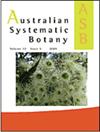The unexpected, recent history of horsetails in Australia
IF 1.6
3区 生物学
Q4 EVOLUTIONARY BIOLOGY
引用次数: 5
Abstract
A new fossil flora from central Queensland, of late Eocene or early Oligocene age, has yielded a diverse assemblage of flowering plants and ferns, including the first evidence of horsetails (Equisetum L.) from the Cenozoic of Australia. The fossils assigned to Equisetum are based on a stem fragment, 2–3mm in diameter, and spreading leaf sheath and diaphragm. The leaf sheath is interpreted to consist of ~24–30 leaves. The spatial arrangement of regularly arranged depressions in a section of the outer cortex is interpreted as evidence of the leaf vascular traces, and indicates a similar number of vascular traces. This specimen provides the youngest evidence of the genus from Australia and indicates that Equisetum survived for at least another 50 million years after it was thought to be extinct in Australia. Whereas molecular data for extant species of Equisetum collectively suggest a comparatively recent origin and radiation, the fossil record of the genus indicates a significantly longer and more complex history. Fossils, such as the new specimen from Makowata, Queensland, will, therefore, play a key role in understanding the history and past distribution of Equisetum in Australia. A key challenge is to assemble and characterise the morphological traits of these living and fossil plants to better understand the origins, history and radiation of this remarkable group of euphyllophytes.澳大利亚马尾的意外近代史
昆士兰中部的一个新的植物化石,年代为始新世晚期或渐新世早期,产生了多种开花植物和蕨类植物,包括澳大利亚新生代马尾(Equisetum L.)的第一个证据。木贼属的化石是基于一个直径为2-3mm的茎碎片,以及展开的叶鞘和横隔膜。叶鞘被认为由约24-30片叶子组成。外层皮层一部分中规则排列的凹陷的空间排列被解释为叶维管痕迹的证据,并表明维管痕迹数量相似。该标本提供了澳大利亚最年轻的木贼属证据,表明木贼在澳大利亚被认为已经灭绝后,至少又存活了5000万年。尽管木贼属现存物种的分子数据共同表明其起源和辐射相对较近,但该属的化石记录表明其历史要长得多,也要复杂得多。因此,化石,如来自昆士兰Makowata的新标本,将在了解木贼在澳大利亚的历史和过去分布方面发挥关键作用。一个关键的挑战是收集和表征这些活植物和化石植物的形态特征,以更好地了解这一著名的胡叶植物群的起源、历史和辐射。
本文章由计算机程序翻译,如有差异,请以英文原文为准。
求助全文
约1分钟内获得全文
求助全文
来源期刊

Australian Systematic Botany
生物-进化生物学
CiteScore
3.10
自引率
12.50%
发文量
12
审稿时长
>12 weeks
期刊介绍:
Australian Systematic Botany is an international journal devoted to the systematics, taxonomy, and related aspects of biogeography and evolution of all algae, fungi and plants, including fossils. Descriptive taxonomic papers should normally constitute a comprehensive treatment of a group. Short papers on individual species and nomenclatural papers must contain significant new information of broader interest to be considered. The prestigious L.A.S. Johnson Review Series is published. Other review articles will also be considered. All papers are peer reviewed.
Australian Systematic Botany is published with the endorsement of the Commonwealth Scientific and Industrial Research Organisation (CSIRO) and the Australian Academy of Science.
 求助内容:
求助内容: 应助结果提醒方式:
应助结果提醒方式:


